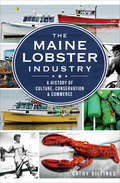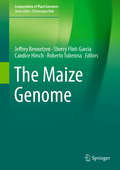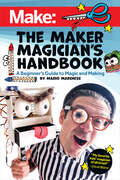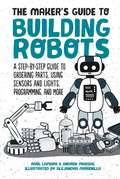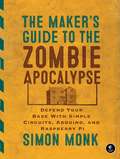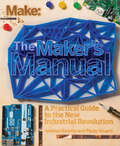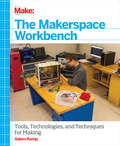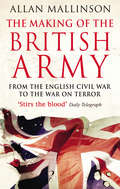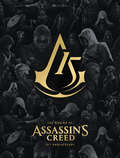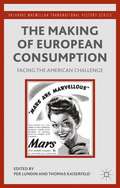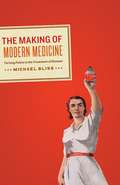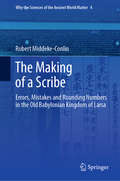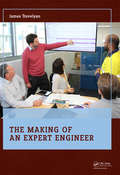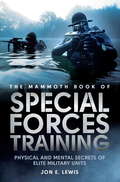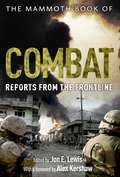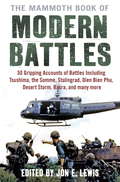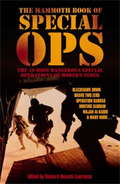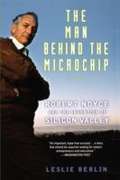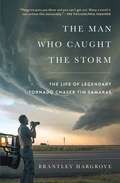- Table View
- List View
The Maillard Reaction in Food Chemistry: Current Technology and Applications (SpringerBriefs in Molecular Science)
by Dongliang Ruan Hui Wang Faliang ChengThis book is devoted to the characterization of Maillard reaction products using mass spectrometry (MS)-based technologies. The Maillard reaction is a well-known non-enzymatic reaction between reducing sugars and proteins, and one of the most important reactions in food sciences. The authors explore different MS-based technologies to systematically investigate the Maillard reaction from amino acids, peptides and proteins. By using amino acid/peptide-sugar models, the authors also show how reactants, temperature and time affect the Maillard reaction. In this book, readers will learn more about glucosylation, and how it can improve functional properties of food proteins.
The Maine Lobster Industry: A History of Culture, Conservation & Commerce
by Cathy BillingsAn inside look at the history and traditions behind this New England delicacy. Since the first recorded lobster catch in 1605, the Maine lobster fishery has grown into a multibillion-dollar force. In this book, Cathy Billings of the University of Maine Lobster Institute embarks on a journey from trap to plate, introducing readers to lobstermen, boat builders, bait dealers, marine suppliers, and the expansive industry that revolves around the fishery. Maine lobster families extend for generations back, and strides in sustainability have been a hallmark of the Maine fishery throughout the centuries—from the time lobstermen themselves introduced conservation measures in the mid-1800s. Today, Maine&’s lobster fishery is a model of a co-managed, sustainable fishery. The people who work Maine&’s lobster fishery have developed a coastal economy with an international influence and deep history, and this book takes you behind the scenes.
The Maize Genome (Compendium of Plant Genomes)
by Roberto Tuberosa Jeffrey Bennetzen Sherry Flint-Garcia Candice HirschThis book discusses advances in our understanding of the structure and function of the maize genome since publication of the original B73 reference genome in 2009, and the progress in translating this knowledge into basic biology and trait improvement. Maize is an extremely important crop, providing a large proportion of the world’s human caloric intake and animal feed, and serving as a model species for basic and applied research. The exceptionally high level of genetic diversity within maize presents opportunities and challenges in all aspects of maize genetics, from sequencing and genotyping to linking genotypes to phenotypes. Topics covered in this timely book range from (i) genome sequencing and genotyping techniques, (ii) genome features such as centromeres and epigenetic regulation, (iii) tools and resources available for trait genomics, to (iv) applications of allele mining and genomics-assisted breeding. This book is a valuable resource for researchers and students interested in maize genetics and genomics.
The Maker Magician's Handbook: A Beginner's Guide to Magic + Making
by Mario MarcheseTo get started, you'll need only what you can usually find in your home: items like paper, ziploc bags, index cards, coloring utensils, pencils, rubberbands, scissors, etc. As we progress in the world of making magic, we'll explore how to use 3D design tools like Tinkercad (you can register for a free account at tinkercad.com). You don't need a 3D printer in your home! Libraries, schools, and makerspaces around the world have 3D printers you can use! We'll explore simple programming using Arduino!
The Maker's Guide to Building Robots: A Step-by-Step Guide to Ordering Parts, Using Sensors and Lights, Programming, and More
by Raúl Laperia Andreu MarsalDiscover that our lives are surrounded by robots. Learn what they are, where they come from and their importance today as well as meeting some of the most famous robots in history! You see them at the movies and on TV, but you also have them in the kitchen and on your computer. They help us to forecast the weather, they adjust the fridge temperature and they vacuum the dust from our homes in our absence. Robots are everywhere! But we love this invasion. Little by little, these creatures have almost become our best friends. That’s why you need to get to know them well, to know how they work and what their use is. You will find all this and much more in this book. In addition, you will learn how to build your own robot. That’s a good plan, right? Quick! Find your favorite seat, get yourself comfy, open this book, and say hello to our robots!
The Maker's Guide to the Zombie Apocalypse: Defend Your Base with Simple Circuits, Arduino, and Raspberry Pi
by Simon MonkWhere will you be when the zombie apocalypse hits? Trapping yourself in the basement? Roasting the family pet? Beheading reanimated neighbors?No way. You’ll be building fortresses, setting traps, and hoarding supplies, because you, savvy survivor, have snatched up your copy of The Maker's Guide to the Zombie Apocalypse before it’s too late. This indispensable guide to survival after Z-day, written by hardware hacker and zombie anthropologist Simon Monk, will teach you how to generate your own electricity, salvage parts, craft essential electronics, and out-survive the undead.,p>Take charge of your environment:–Monitor zombie movement with trip wires and motion sensors–Keep vigilant watch over your compound with Arduino and Raspberry Pi surveillance systems–Power zombie defense devices with car batteries, bicycle generators, and solar powerEscape imminent danger:–Repurpose old disposable cameras for zombie-distracting flashbangs–Open doors remotely for a successful sprint home–Forestall subplot disasters with fire and smoke detectorsCommunicate with other survivors:–Hail nearby humans using Morse code–Pass silent messages with two-way vibration walkie-talkies–Fervently scan the airwaves with a frequency hopperFor anyone from the budding maker to the keen hobbyist, The Maker’s Guide to the Zombie Apocalypse is an essential survival tool.Uses the Arduino Uno board and Raspberry Pi Model B+ or Model 2
The Maker's Manual: A Practical Guide to the New Industrial Revolution
by Patrick Di Justo Paolo Aliverti Andrea MaiettaThe Maker's Manual is a practical and comprehensive guide to becoming a hero of the new industrial revolution. It features dozens of color images, techniques to transform your ideas into physical projects, and must-have skills like electronics prototyping, 3d printing, and programming. This book's clear, precise explanations will help you unleash your creativity, make successful projects, and work toward a sustainable maker business. Written by the founders of Frankenstein Garage, which has organized courses since 2011 to help makers to realize their creations, The Maker's Manual answers your questions about the Maker Movement that is revolutionizing the way we design and produce things.
The Makerspace Workbench: Tools, Technologies, and Techniques for Making
by Adam KempCreate a dynamic space for designing and building DIY electronic hardware, programming, and manufacturing projects. With this illustrated guide, you’ll learn the benefits of having a Makerspace—a shared space with a set of shared tools—that attracts fellow makers and gives you more resources to work with. You’ll find clear explanations of the tools, software, materials, and layout you need to get started—everything from basic electronics to rapid prototyping technology and inexpensive 3D printers.A Makerspace is the perfect solution for many makers today. While you can get a lot done in a fully-decked out shop, you’ll always have trouble making space for the next great tool you need. And the one thing you really miss out on in a personal shop is the collaboration with other makers. A Makerspace provides you with the best of both worlds.Perfect for any maker, educator, or community, this book shows you how to organize your environment to provide a safe and fun workflow, and demonstrates how you can use that space to educate others.
The Making Of The British Army
by Allan MallinsonEdgehill, 1642: Surveying the disastrous scene in the aftermath of the first battle of the English Civil War, Oliver Cromwell realized that war could no longer be waged in the old, feudal way: there had to be system and discipline, and therefore - eventually - a standing professional army.From the 'New Model Army' of Cromwell's distant vision, former soldier Allan Mallinson shows us the people and events that have shaped the British army we know today. How Marlborough's momentous victory at Blenheim is linked to Wellington's at Waterloo; how the desperate fight at Rorke's Drift in 1879 underpinned the heroism of the airborne forces at Arnhem in 1944; and why Montgomery's momentous victory at El Alamein mattered long after the Second World War was over . . . From the British Army's origins at the battle of Edgehill to the recent conflict in Afghanistan, The Making of the British Army is history at its most relevant - and most dramatic.
The Making of Assassin's Creed: 15th Anniversary
by Ubisoft Alex CalvinAn oversized full-color hardcover that celebrates fifteen years of the iconic Assassin&’s Creed video game saga!Discover the genesis of each Assassin&’s Creed game and get an insider's look at the efforts that went into creating one the biggest franchises in the video game industry.In observance of Assassin&’s Creed&’s fifteen-year anniversary, Ubisoft and Dark Horse Books have teamed up to create an extensive examination into the creation of the award-winning Assassin&’s Creed franchise. Featuring gorgeous art from over a decade-and-a-half of development, and detailed interviews with the games&’ past and present creators, this is the perfect companion piece for any aspiring Assassin.
The Making of European Consumption
by Per Lundin Thomas KaiserfeldAmerican ideals and models feature prominently in the master narrative of post-war European consumer societies. This book demonstrates that Europeans did not appropriate a homogenous notion of America, rather post-war European consumption was a process of selective appropriation of American elements.
The Making of Modern Medicine: Turning Points in the Treatment of Disease
by Michael BlissAt the dawn of the twenty-first century, we have become accustomed to medical breakthroughs and conditioned to assume that, regardless of illnesses, doctors almost certainly will be able to help not just by diagnosing us and alleviating our pain, but by actually treating or even curing diseases, and significantly improving our lives. For most of human history, however, that was far from the case, as veteran medical historian Michael Bliss explains in "The Making of Modern Medicine. " Focusing on a few key moments in the transformation of medical care, Bliss reveals the way that new discoveries and new approaches led doctors and patients alike to discard fatalism and their traditional religious acceptance of suffering in favor of a new faith in health care and in the capacity of doctors to treat disease. He takes readers in his account to three turning points a devastating smallpox outbreak in Montreal in 1885, the founding of the Johns Hopkins Hospital and Medical School, and the discovery of insulin and recounts the lives of three crucial figures researcher Frederick Banting, surgeon Harvey Cushing, and physician William Osler turning medical history into a fascinating story of dedication and discovery. Compact and compelling, this searching historyvividly depicts and explains the emergence of modern medicine and, in a provocative epilogue, outlines the paradoxes and confusions underlying our contemporary understanding of disease, death, and life itself. "
The Making of a Scribe: Errors, Mistakes and Rounding Numbers in the Old Babylonian Kingdom of Larsa (Why the Sciences of the Ancient World Matter #4)
by Robert Middeke-ConlinThis book presents a novel methodology to study economic texts. The author investigates discrepancies in these writings by focusing on errors, mistakes, and rounding numbers. In particular, he looks at the acquisition, use, and development of practical mathematics in an ancient society: The Old Babylonian kingdom of Larsa (beginning of the second millennium BCE Southern Iraq). In so doing, coverage bridges a gap between the sciences and humanities. Through this work, the reader will gain insight into discrepancies encountered in economic texts in general and rounding numbers in particular. They will learn a new framework to explain error as a form of economic practice. Researchers and students will also become aware of the numerical and metrological basis for calculation in these writings and how the scribes themselves conceptualized value. This work fills a void in Assyriological studies. It provides a methodology to explore, understand, and exploit statistical data. The anlaysis also fills a void in the history of mathematics by presenting historians of mathematics a method to study practical texts. In addition, the author shows the importance mathematics has as a tool for ancient practitioners to cope with complex economic processes. This serves as a useful case study for modern policy makers into the importance of education in any economy.
The Making of an Expert Engineer
by James TrevelyanThis book sets out the principles of engineering practice, knowledge that has come to light through more than a decade of research by the author and his students studying engineers at work. Until now, this knowledge has been almost entirely unwritten, passed on invisibly from one generation of engineers to the next, what engineers refer to asexpe
The Mammoth Book Of Special Forces Training: Physical and Mental Secrets of Elite Military Units (Mammoth Books #388)
by Jon E. LewisIn this encyclopedic book, Lewis provides insights into the origins, training, tactics, weapons and achievements of special forces and special mission units throughout the world, focusing particularly on US and UK forces. He also looks at the codes that that bind the members of these elite units together. He reveals training secrets in everything from wilderness survival to hand-to-hand combat. In doing so, he draws extensively on biographies, autobiographies, training manuals, interviews and press coverage of key operations. The elite forces covered include: The British Army’s Special Air Service (SAS), established in 1950, which has served as a model for the special forces of many countries. Its counter-terrorist wing famously took part in the hostage rescue during the siege of the Iranian Embassy in London in 1980. The Parachute Regiment, the airborne infantry element of 16 Air Assault Brigade, which spearheads the British Army’s rapid intervention capability. It is closely linked to United Kingdom Special Forces. The US Navy’s SEALS (Sea, Air, Land Teams), trained to conduct special operations in any environment, but uniquely specialised and equipped to operate from and in the sea. Together with speedboat-operating Naval Special Warfare Combatant-Craft Crewmen, they form the operational arm of the Naval Special Warfare community, the Navy component of the US Special Operations Command. Their special operations include: neutralizing enemy forces; reconnaissance; counter-terrorism (famously in the killing of Osama bin Laden); and training allies. The US Army’s Delta Force: The Special Mission Unit, 1st Special Forces Operational Detachment-Delta (1st SFOD-D), known simply as Delta Force, the Army component of Joint Special Operations Command. Its role is counter-terrorism, direct action and national intervention operations, though it has the capability to conduct many different kinds of clandestine missions, including hostage rescues and raids. The US Army Rangers, a light infantry combat formation under the US Army Special Operation Command. The Green Berets – motto: ‘to free the oppressed’ – trained in languages, culture, diplomacy, psychological warfare and disinformation. Russia’s Spetsnaz, whose crack anti-terrorist commandos ended the Moscow theatre siege, and who have a reputation for being among the world’s toughest and most ruthless soldiers. Spetsnaz units saw extensive action in Afghanistan and Chechnya, often operating far behind enemy lines. Israeli Special Forces, especially Shayetet 13 (Flotilla 13), whose motto, in common with the rest of the Israeli military, is ‘Never again’, a reference to the Holocaust. They are particularly adept at the specifically Israeli martial art Krav Maga, which they dub ‘Jew-jitsu’.
The Mammoth Book of Combat: Reports From The Frontline (Mammoth Ser.)
by Jon E. LewisOver a hundred eyewitness accounts of the reality of combat from some of the finest writers of the last century and our own. Lucid, vivid, complex images of conflict, from Walt Whitman on the American Civil War to contemporary reporting from Afghanistan.The collection includes Martha Gellhorn on the Battle of the Bulge, Michael Herr at Khe Sanh, David Rohde's and Anthony Shadid's Pulitzer-winning accounts of Bosnia and Iraq respectively, Christina Lamb's famous account of being under fire from the Taliban, Robert Fisk on being attacked in Afghanistan, and Nicholas Tomalin's 'The General Goes Zapping Charlie Kong' (one of the inspirations for Apocalypse Now) among many other pieces of exceptional war reporting.
The Mammoth Book of Combat: Reports from the Frontline (Mammoth Books #368)
by Jon E. LewisOver a hundred eyewitness accounts of the reality of combat from some of the finest writers of the last century and our own. Lucid, vivid, complex images of conflict, from Walt Whitman on the American Civil War to contemporary reporting from Afghanistan.The collection includes Martha Gellhorn on the Battle of the Bulge, Michael Herr at Khe Sanh, David Rohde's and Anthony Shadid's Pulitzer-winning accounts of Bosnia and Iraq respectively, Christina Lamb's famous account of being under fire from the Taliban, Robert Fisk on being attacked in Afghanistan, and Nicholas Tomalin's 'The General Goes Zapping Charlie Kong' (one of the inspirations for Apocalypse Now) among many other pieces of exceptional war reporting.
The Mammoth Book of Modern Battles (Mammoth Books #381)
by Jon E. LewisFrom the start of the 20th century to the most recent major offensives, here are fifty accounts of the battles that made the modern world, described in superb detail by historians and writers including John Keegan, Alan Clark, John Strawson, Charles Mey, John Pimlott, and John Laffin.All the major conflicts are covered, from two world wars, through Korea, Vietnam, Bosnia, Chechnya, to Iraq and Afghanistan. Among the battles featured are: the Somme, Passchendaele, Battle of Britain, Stalingrad, El Alamein, Monte Cassino, Omaha Beach, Iwa Jima, Dien Bien Phu, Ia Drang, Hamburger Hill, Desert Storm, Kabul, Baghdad, and Basra.
The Mammoth Book of Modern Battles (Mammoth Books)
by Jon E. LewisFrom the start of the 20th century to the most recent major offensives, here are fifty accounts of the battles that made the modern world, described in superb detail by historians and writers including John Keegan, Alan Clark, John Strawson, Charles Mey, John Pimlott, and John Laffin.All the major conflicts are covered, from two world wars, through Korea, Vietnam, Bosnia, Chechnya, to Iraq and Afghanistan. Among the battles featured are: the Somme, Passchendaele, Battle of Britain, Stalingrad, El Alamein, Monte Cassino, Omaha Beach, Iwa Jima, Dien Bien Phu, Ia Drang, Hamburger Hill, Desert Storm, Kabul, Baghdad, and Basra.
The Mammoth Book of Special Ops
by Richard Russell LawrenceInto the eye of danger with the men who put the 'special' in special forcesThe once shadowy activities of special forces have grown into an increasingly exposed element of 21st century warfare and anti-terrorist activity. Here, in one giant unputdownable volume, are 30 of the most dangerous special operations of modern times.Drawn from the flashpoints of the world, and above all Iraq and Afghanistan, these first-hand and reported accounts of missions by the SAS, Delta Force, Green Beret, Commandos and other forces will leave you on the edge of your seat.The accounts include:? Blackhawk Down - the US Delta forces debacle in Mogadishu, Somalia, 1993? British Special forces fight Al Qaeda at close quarters in Afghanistan 2003? Task Force Raider - US Special forces teams track down Saddam Hussein, 2003? The British 'Blackhawk Down' - Paras shoot their way out of trouble in Majar, Iraq 2003? The capture of insurgent leader Chemical Evil Fat Mama, Fallujah, November 2003
The Mammoth Book of Special Ops (Mammoth Books #359)
by Richard Russell LawrenceInto the eye of danger with the men who put the 'special' in special forcesThe once shadowy activities of special forces have grown into an increasingly exposed element of 21st century warfare and anti-terrorist activity. Here, in one giant unputdownable volume, are 30 of the most dangerous special operations of modern times.Drawn from the flashpoints of the world, and above all Iraq and Afghanistan, these first-hand and reported accounts of missions by the SAS, Delta Force, Green Beret, Commandos and other forces will leave you on the edge of your seat.The accounts include: Blackhawk Down - the US Delta forces debacle in Mogadishu, Somalia, 1993 British Special forces fight Al Qaeda at close quarters in Afghanistan 2003 Task Force Raider - US Special forces teams track down Saddam Hussein, 2003 The British 'Blackhawk Down' - Paras shoot their way out of trouble in Majar, Iraq 2003 The capture of insurgent leader Chemical Evil Fat Mama, Fallujah, November 2003
The Man Behind The Microchip: Robert Noyce And The Invention Of Silicon Valley
by Leslie BerlinHailed as the Thomas Edison and Henry Ford of Silicon Valley, Robert Noyce was a brilliant inventor, a leading entrepreneur, and a daring risk taker who piloted his own jets and skied mountains accessible only by helicopter. Now, in The Man Behind the Microchip, Leslie Berlin captures not only this colorful individual but also the vibrant interplay of technology, business, money, politics, and culture that defines Silicon Valley. Here is the life of a high-tech industry giant. The co-founder of Fairchild Semiconductor and Intel, Noyce co-invented the integrated circuit, the electronic heart of every modern computer, automobile, cellular telephone, advanced weapon, and video game. With access to never-before-seen documents, Berlin paints a fascinating portrait of Noyce: an ambitious and intensely competitive multimillionaire who exuded a "just folks" sort of charm, a Midwestern preacher's son who rejected organized religion but would counsel his employees to "go off and do something wonderful," a man who never looked back and sometimes paid a price for it. In addition, this vivid narrative sheds light on Noyce's friends and associates, including some of the best-known managers, venture capitalists, and creative minds in Silicon Valley. Berlin draws upon interviews with dozens of key players in modern American business--including Andy Grove, Steve Jobs, Gordon Moore, and Warren Buffett; their recollections of Noyce give readers a privileged, first-hand look inside the dynamic world of high-tech entrepreneurship. A modern American success story, The Man Behind the Microchip illuminates the triumphs and setbacks of one of the most important inventors and entrepreneurs of our time.
The Man Who Caught the Storm: The Life of Legendary Tornado Chaser Tim Samaras
by Brantley Hargrove“An instant classic of Americana—a story of tragedy, invention, lore, science, and a most original kind of genius.” —Hampton Sides “Masterful. This is what man versus nature is all about.” —Skip Hollandsworth The Man Who Caught the Storm is the saga of the greatest tornado chaser who ever lived: a tale of obsession and daring, and an extraordinary account of humanity’s high-stakes race to understand nature’s fiercest phenomenon.At the turn of the twenty-first century, the tornado was one of the last true mysteries of the modern world. It was a monster that ravaged the American heartland a thousand times each year, yet science’s every effort to divine its inner workings had ended in failure. Researchers all but gave up, until the arrival of an outsider. In a field of PhDs, Tim Samaras didn’t attend a day of college in his life. He chased storms with brilliant tools of his own invention and pushed closer to the tornado than anyone else ever dared. When he achieved what meteorologists had deemed impossible, it was as if he had snatched the fire of the gods. Yet even as he transformed the field, Samaras kept on pushing. As his ambitions grew, so did the risks. And when he finally met his match—in a faceoff against the largest tornado ever recorded—it upended everything he thought he knew. Brantley Hargrove delivers a masterful tale, chronicling the life of Tim Samaras in all its triumph and tragedy. He takes readers inside the thrill of the chase, the captivating science of tornadoes, and the remarkable character of a man who walked the line between life and death in pursuit of knowledge. Following the tradition of Into Thin Air and The Perfect Storm, Hargrove’s debut offers an unforgettable exploration of obsession and the extremes of the natural world.

